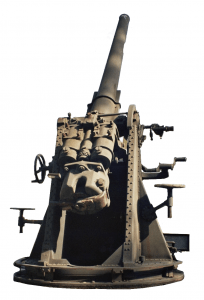
Under the sponsorship of the Royal Navy, the 3 inch 20 cwt Gun began development prior to World War 1. Both the Royal Navy and the Army accepted it for service in 1914 as the standard anti-aircraft gun. The original mounting was a static pedestal for anchoring in concrete. Mobile mountings came into use later. Sighting was direct with open sights. In the late 1930’s, some guns had data-recieving dials fitted. They could then be under predictor control. It became obsolete in 1946.
Gun
| Mark-1 | Wire wound, vertical sliding breech, rifled 1/30 |
| Mark-1* | As Mark-1 but rifled 1/40. Later re-lined & rifled 1/30 |
| Mark-1** | Mark-3 converted back to Mark-1 breech mechanism in 1923 |
| Mark-1*** | Mark-3* converted back to Mark-1 breech mechanism in 1923 |
| Mark-1A | Marks-1 to 1*** repaired by removing “A” tube & inserting auto-frettaged loose liner in 1933 |
| Mark-1B | New manufacture with auto-frettaged loose liner, 1933 |
| Mark-1D | Naval. Auto-frettaged monobloc barrel, 1941 |
| Mark-1E | Naval. Monobloc barrel of high-yield steel, 1941 |
| Mark-2 | Naval. As Mark-1 but differences in breech ring to suit naval mounting |
| Mark-2* | As Mark-2 but rifled 1/40, 1918 |
| Mark-2C | Mark-2 repaired as for Mark-1A |
| Mark-3 | As for Mark-1 but with screw breech mechanism, 1917 |
| Mark-3* | As Mark-3 but rifled 1/40, 1918 |
| Mark-3A | Mark-3 or 3* repaired as for Mark-1A, 1933 |
| Mark-4 | Monobloc gun with Wellin screw breech, 1916. Obsolete 1926 |
| Mark-4* | As Mark-4 but rifled 1/40 |
Carriage & Mountings
| Mark-1 | Pedestal, variable recoil, 2 speed elevating gear |
| Mark-2 | As Mark-1 but 1 speed elevating gear, constant length recoil |
| Mark-3 | Simplified Mark-2 for war time production 1916 |
| Mark-4 | Added run out control for semi-automatic breech |
| Mark-4A | Without run out control for screw breech guns |
| Lorry Peerless AA | Commercial truck carrying Mark-4 mount. Solid tyres, fring support jacks |
| Platform-2 wheeled Mark-1 | Square platform, single axle, short outriggers, 1916. Pneumatic tyres fitted 1938 |
| Platform-4 wheeled Marks 1 & 2 | Pneumatic tyres, cone jacks for levelling & support, 1928 |
| Platform-4 wheeled Mark-3 | As Mark-2 but with mechanical 4-wheel brakes |
| Platform-4 wheeled Mark-3A | As Mark-2 but with Warner Electric brakes |
| Platform-4 wheeled Mark-3B | As Mark-3A but different pattern of Warner brakes |
| Platform-4 wheeled Marks 4, 4A & 4B | Similar to Marks 3, 3A & 3B but with different jacking system |
Data
Gun Mark-1 on Mounting Mark-1
| Weight of gun & breech mechanism | 2,250 lbs |
| Total length | 140 inches |
| Length of bore | 135 inches (45 calibres) |
| Rifling | 20 grooves, uniform, right hand, 1/30 |
| Breech mechanism | Vertical sliding block, semi-automatic, percussion fired |
| Elevation | -10° to +90° |
| Traverse | 360° |
| Recoil system | Hydro-spring, variable, 11 to 20 inches |
| Weight in action | 6,000 lbs |
| Rate of fire | 20 – 25 rounds per minute |
Performance
Firing standard 16.5 lb HE Shell
| Muzzle velocity | 2,000 feet/second |
| Maximum horizontal range | 12,400 yards |
| Maximum ceiling | 25,200 feet |
| Effective ceiling | 15,700 feet |
| An earlier pattern of 12.5 lb shell gave the following performance | |
| Muzzle velocity | 2,500 feet/second |
| Maximum horizontal range | 10,900 yards |
| Maximum ceiling | 37,200 feet |
| Effective ceiling | 23,500 feet |
Ammunition
Fixed case charge
Over its service, the gun had many different varieties of ammunition issued. A list for WW1 shows 215 combinations of charge & shell. An inventory from 1943 still lists 66 different complete rounds in service. The list below, therefore, is a representative one only.
| Shell, HE, Mark-2B | Flat based shell with Time Fuze No. 199 |
| Shell, Shrapnel, Mark-2BT | Base tracer, Time Fuze No. 199. For low flying aircraft |
| Shot, AP, Mark-2T | Integral tracer. Penetration 84mm at 1,00 yards & 30° angle |
| Propelling charge | Brass case, 2 lb 2 oz of Cordite with Precussion Primer No. 1 |
